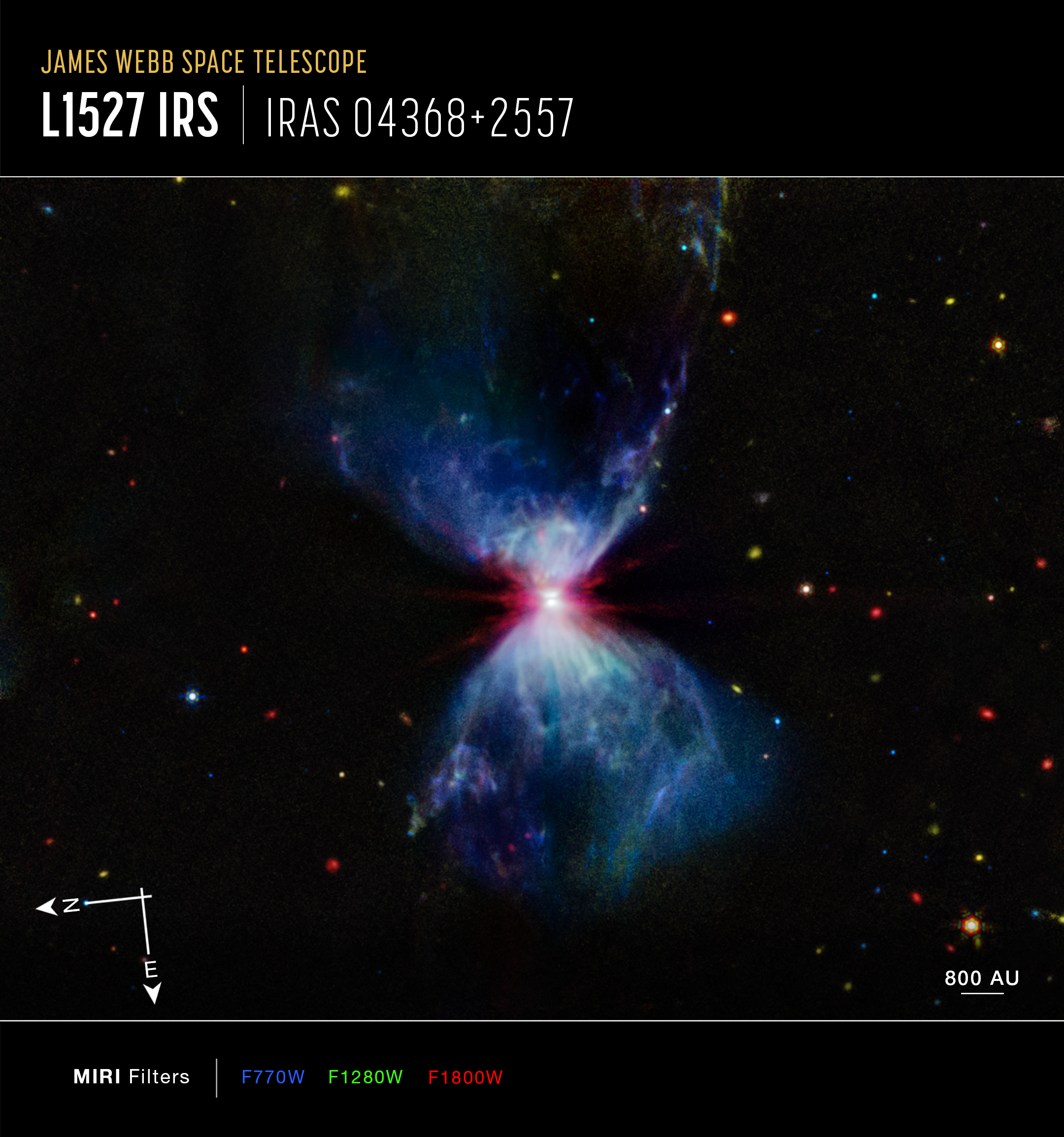1 min read
L1527 and Protostar (MIRI Compass Image)

This image of the nebula L1527, captured by Webb’s Mid-Infrared Instrument (MIRI), shows compass arrows, a scale bar, and color key for reference.
The north and east compass arrows show the orientation of the image on the sky. Note that the relationship between north and east on the sky (as seen from below) is flipped relative to direction arrows on a map of the ground (as seen from above).
The scale bar is labeled in astronomical units (AU), which is the average distance between Earth and the Sun, or 93 million miles (150 million kilometers).
This image shows invisible mid-infrared wavelengths of light that have been translated into visible-light colors. The color key shows which MIRI filters were used when collecting the light. The color of each filter name is the visible light color used to represent the infrared light that passes through that filter.
Extended Description and Image Alt Text
Extended Description
Image titled “James Webb Space Telescope, L1527 IRS, IRAS 04368+2557” with compass arrows, scale bar, and color key.
Image
A growing protostar embedded within a molecular cloud. The center of the image shows a bright, red region, where the growing protostar resides, with a thin, gray lane of matter cutting through it horizontally, which is the protostar’s accretion disk. Above and below this region are blue triangular-shaped molecular clouds, which give the overall object an hourglass shape. The areas in the molecular clouds closest to the protostar have more pronounced plumes of blue gas. There are red, yellow, orange, blue, and green stars and galaxies scattered across the background.
Compass Arrows, Scale Bar, and Color Key
At the bottom left are compass arrows indicating the orientation of the image on the sky. The north arrow points in the 8 o’clock direction. The east arrow points toward 5 o’clock. At the lower right is a scale bar labeled 800 AU. The length of the scale bar is one-tenth the total width of the image. Below the image is a color key showing which MIRI filters were used to create the image and which visible-light color is assigned to each filter. From left to right, MIRI filters are: F770W is blue; F1280W is green; and F1800W is red.
Image Alt Text
Image titled “James Webb Space Telescope, L1527 IRS, IRAS 04368+2557” with compass arrows, scale bar, and color key. A growing protostar embedded within a molecular cloud. The center of the image shows a bright, red region, where the growing protostar resides, with a thin, gray lane of matter cutting through it horizontally. Above and below this region are blue triangular-shaped molecular clouds, which give the overall object an hourglass shape. There are red, yellow, orange, blue, and green stars and galaxies scattered across the background. At the bottom left are compass arrows indicating the orientation of the image on the sky. The north arrow points in the 8 o’clock direction. The east arrow points toward 5 o’clock. At the lower right is a scale bar labeled 800 AU. Below the image is a color key showing the MIRI filters and their visible-light color assignment. From left to right, MIRI filters are: F770W is blue; F1280W is green; and F1800W is red.
About the Object
- R.A. PositionR.A. PositionRight ascension – analogous to longitude – is one component of an object's position.04:39:53.59
- Dec. PositionDec. PositionDeclination – analogous to latitude – is one component of an object's position.+26:03:05.50
- ConstellationConstellationOne of 88 recognized regions of the celestial sphere in which the object appears.Taurus
- DistanceDistanceThe physical distance from Earth to the astronomical object. Distances within our solar system are usually measured in Astronomical Units (AU). Distances between stars are usually measured in light-years. Interstellar distances can also be measured in parsecs.About 460 light-years
- DimensionsDimensionsThe physical size of the object or the apparent angle it subtends on the sky.Image is 2.37 arcmin across (about 0.32 light-years)
About the Data
- Data DescriptionData DescriptionProposal: A description of the observations, their scientific justification, and the links to the data available in the science archive.
Science Team: The astronomers who planned the observations and analyzed the data. "PI" refers to the Principal Investigator.This image was created from JWST data from proposal: 2739 (K. Pontoppidan)
- InstrumentInstrumentThe science instrument used to produce the data.MIRI
- Exposure DatesExposure DatesThe date(s) that the telescope made its observations and the total exposure time.08 Sep 2022
- FiltersFiltersThe camera filters that were used in the science observations.F770W, F1280W, F1800W
- Object NameObject NameA name or catalog number that astronomers use to identify an astronomical object.L1527 IRS (IRAS 04368+2557)
- Object DescriptionObject DescriptionThe type of astronomical object.Young Stellar Object
- Release DateJuly 2, 2024
- Science ReleaseNASA’s Webb Captures Celestial Fireworks Around Forming Star
- CreditImage: NASA, ESA, CSA, STScI

These images are a composite of separate exposures acquired by the James Webb Space Telescope using the MIRI instrument. Several filters were used to sample different infrared wavelength ranges. The color results from assigning different hues (colors) to each monochromatic (grayscale) image associated with an individual filter. In this case, the assigned colors are: Blue: F770W, Green: F1280W, Red: F1800W
Related Images & Videos

L1527 and Protostar (MIRI Image)
L1527, shown in this image from NASA’s James Webb Space Telescope’s MIRI (Mid-Infrared Instrument), is a molecular cloud that harbors a protostar. It resides about 460 light-years from Earth in the constellation Taurus. The more diffuse blue light and the filamentary structures...
Share
Details
Laura Betz
NASA’s Goddard Space Flight Center
Greenbelt, Maryland
laura.e.betz@nasa.gov
NASA, ESA, CSA, STScI






























